Nissin Di866 Mark II flash was designed to compete with the Canon's flagship unit Speedlite 580EX II. Both flashes meet the needs of professional photographers and photography enthusiasts alike. If you are faced with the question which of these two flashes is for you, this in-depth comparison should help you make a decision.
Please note that we purposely do not compare Nissin Di866 Mark II with the newer Canon Speedlite 600EX-RT. The comparison would not be fair since, as we showed in our Canon Speedlite 580EX II vs. 600EX review, the latest flash from Canon is superior in almost each and every way.
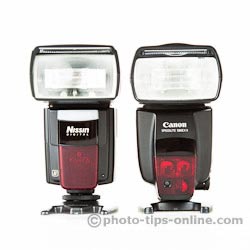 |
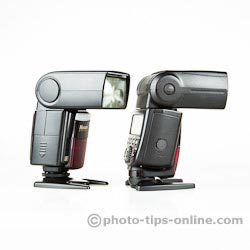 |
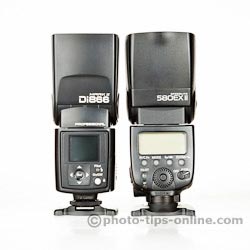 |
Nissin Di866 Mark II has a Guide Number of 60 meters / 197 feet (at 105mm zoom, ISO100), whereas Canon Speedlite 580EX II is rated at 58 meters / 190 feet (with the same settings). Based on these Guide Numbers, you can calculate that Nissin is about 7 percent more powerful. In our tests, however, we couldn't to detect any significant differences. (We used a light meter and also analyzed the final images and histograms). So, we have to conclude that the maximum light outputs of the two flashes are practically the same.
The recycling time measurements were another interesting experiment. According to the manuals, it takes 5 seconds to re-charge 580EX II after a full-power pop. Di866 II is supposed do it in 5.5 seconds (both with fresh Alkaline batteries). We never use Alkaline batteries with our flashes. As many other photographers, we favor Powerex and Sanyo Eneloop re-chargeable batteries. With freshly charged Powerex sets, it takes only 3 seconds to recycle the Canon flash, whereas the Nissin unit requires 4.9 seconds to get ready for the next shot. As you can see, both flashes benefit from the use of Ni-MH batteries and outperform the specs for the Alkaline ones, but Speedlite 580EX II is significantly faster.
While Canon Speedlite 580EX II is often used as a benchmark when it comes to hot-shoe flash quality, Nissin Di866 Mark II also looks and feels well-built and solid. We would say that, in terms of build quality, Di866 Mark II is on par with Nikon Speedlight SB-910 or Metz Mecablitz AF-2, which are also great flashguns, but Speedlite 580EX II still appears to be more rugged.
At the moment, Nissin Di866 Mark II is the only speedlight that features a color LCD. Moreover, the screen menu rotates left and right to stay vertical when you rotate your flash/camera between portrait and landscape orientations. The controls are simplified to a fully symmetrical D-pad with a set buttons in the middle, which is equally convenient to use whether the flash is vertical or sideways.
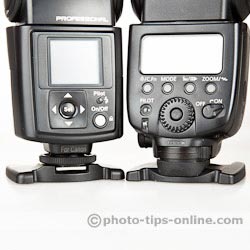 |
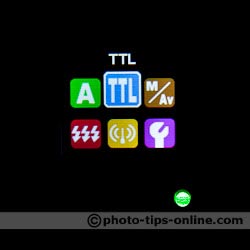 |
We like that Nissin menus are color-coded because it helps you recognize the mode you are in at a glance. In general, Di866 Mark II has a more intuitive and easy to use menu system than Canon 580EX II has. (Specifically, Custom Functions menu is very cryptic on the Canon flash.) To be fair, Canon menus are not bad at all, but the learning curve is steeper compared to Nissin.
The only thing that we were not completely psyched about is Nissin'swireless menu: while it is very easy to understand, changing that many setting with just the D-pad may take some getting used to.
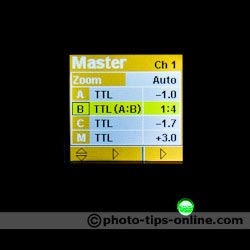 |
Additionally, going between menus on the Nissin flash feels a bit slow, but not to the level when it becomes annoying. However, changing the values of the most important parameters (like, for example, exposure compensation) feels adequate and not laggy.
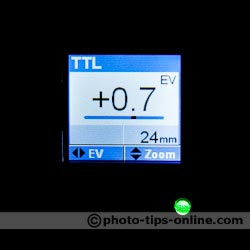 |
Also note that Canon Speedlite 580EX II is fairly widely criticized for the way it enters and exits the wireless mode (you need to hold a button for two seconds). While Di866 II does not have a dedicated switch either, switching to wireless mode can be done under one second.
The best thing about the Speedlite 580EX II interface is the select dial ("the wheel"). We absolutely love this type of controls (not only on flashes, but on camera bodies, as well). Rotating a wheel is far more ergonomic than pressing any type of a button.
Since flash LCD is typically smaller than the one on the camera, it may be a good idea to control your flash using in-camera menus (if your camera has this ability, of course). This feature is invaluable for Canon Speedlite 580EX II because it has a lot of Custom Functions that just impossible to use without the manual, unless you can memorize dozens of random numbers :).
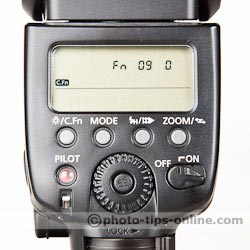 |
As you would expect, 580EX II can be fully controlled with cameras like Canon 50D or 5D Mark II (and later). Nissin Di866 Mark II flash, on the other hand, has only a limited support of in-camera menus. For example, stroboscopic mode or FEB (flash exposure bracketing) cannot be selected in camera. With the Nissin Di866 flash, we actually prefer changing settings on the flash itself, but for someone who is using in-camera flash menus exclusively, this can be a potential workflow problem.
It is probably fair to say that Canon Speedlite 580EX II has a superior flash head design. Both flashes can zoom from 24mm to 105mm, but with the wide-angle panel pulled out, the Canon unit covers 14mm angle of view, whereas the Nissin flash only goes as wide as 18mm.
Also, Di866 Mark II rotates 180 degrees to the right, 90 degrees to the left, and it does not tilt down (only up). Speedlite 580EX II does full 360 degrees horizontally and can tilt down 7 degrees to aid macro shots.
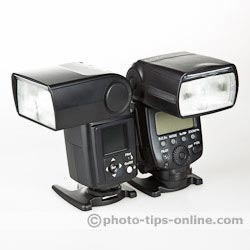 |
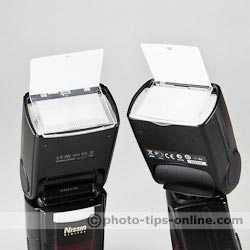 |
We like that Nissin flash can be freely rotated and titled at any time. With the Canon unit, you need to press and hold the release button before rotating. The caveat of the Nissin's approach, however, is that you may have troubles using some of the relatively heavy light modifiers, such as Gary Fong Lightsphere or Rogue Large FlashBender. When in the upright position, the flash head may slam down when you move around if a heavy diffuser is attached. With the majority of light modifiers, however, Nissin Di866 Mark II works just as well as Canon Speedlite 580EX II does.
For some photography applications, it may be important to stay as quiet as possible. If it is a requirement, you will appreciate that 580EX II operates absolutely silently. Di866 Mark II produces the typical high-pitched noise when internal capacitors are re-charging after a burst of light. For most users, however, this will not be am issue.
Additionally, it turned out that Nissin Di866 II makes a noticeable crackling sound when turned on. The sound is not loud but so unusual for a flash, that we got concerned about it and contacted Nissin's customer support to make sure the flash was not defective. We were assured that the noise was normal for this model and was not an indication of any problem. We've been using Di866 II for several months now, and so far it did not let us down in any way.
Secondary flash (or sub-flash) is a feature that can be found on several other third-party flashes, like, for example, Metz top-of-the-line units. Nissin Di866 Mark II allows you to utilize the sub-flash when the flash head is set to a bounce position. The secondary flash has a Guide Number of 12 meters (39 feet) at ISO 100, and it can be useful as a fill light. Regardless of the flash mode, the sub-flash output has to be set manually from full to 1/128 of its power.
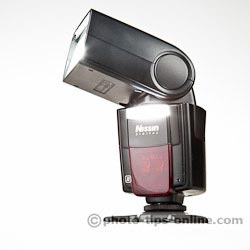 |
We have previously tested the secondary flash of Metz Mecablitz 58 AF-1, so you may want to take a look what kind of images you can produce using the main flash for bouncing and sub-flash for fill: Metz Mecablitz 58 AF-1 flash test. (Note that the actual result will vary greatly depending on the environment you shoot in.)
Canon 580EX II does not offer a secondary flash, but you can achieve similar results using a variable angle bounce card, such as Demb Flip-it! or Rouge FlashBender Bounce Card.
Both, Nissin Di866 II and Canon 580EX II, can be used as a master or slave in the Canon's proprietary wireless configuration. They support all 4 channels and 3 groups (A, B, and C) with ratios and flash exposure compensation per group. The Nissin flash, however, has a bonus feature: flash exposure of the master can be controlled independently from Group A. Speedlite 580EX II, when set as a master, always belongs to Group A, whereas a Nissin master has a groups of its own called M. Effectively, using Di866 Mark II, you get a whole extra group of a single flash. While it may not be a major deal, some users will definitely appreciate the additional flexibility.
Many Canon flash users wished for a "dumb" optical triggering capability when a flash could be triggered by any pulse of light. None of the Canon Speedlites offer such a function at the moment. On the contrary, Di866 Mark II offers two optical slave modes, which allow it to be either triggered by a manual flash (studio strobe, for example) or a TTL flash (including virtually any point-and-shoot camera). If you set your Nissin flash to SD mode, it will ignore the pre-flashes coming from an E-TTL, iTTL, P-TTL, or any other advanced metering system, and it will fire together with the main burst of light. We really like this feature and find it very handy.
In the external metering mode (also known as auto mode), the flash itself decides how much light to throw toward the subject. It uses a built-in sensor to measure the reflected light and cut the light out when the scene is sufficiently illuminated. For the external metering to work properly, the flash has to know the ISO and aperture (f-stop) of the camera. Canon Speedlite 580EX II flash can read these settings automatically with compatible camera bodies, whereas Nissin Di866 Mark II requires the camera parameters to be entered manually. If you use external metering often, you may want to take a note of this limitation. For us, it is not an issue since we are typically staying away from the auto mode.
Canon Speedlite 580EX II is known for causing RF interference that reduces the effective range of Pocket Wizard Flex TT5 radio triggers. RF shields have been developed over time to get around this problem. Nissin Di866 Mark II seems to behave better in this regard. In our outdoor tests, we were able to get about 30-40% better range with the Nissin flash (in the identical setups with no RF shields used).
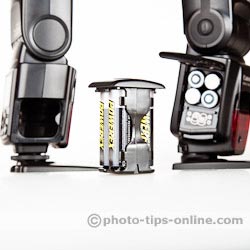 |
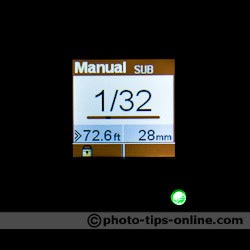 |
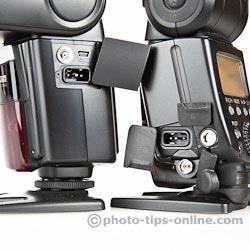 |
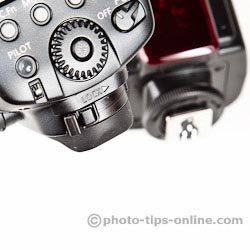 |
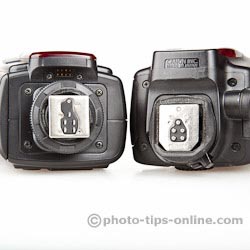 |
AF-assist range on both flashes is rated up to 10 m / 33 ft. In our quick tests with the center AF point, the performance of the AF-assist beams turned out to be very similar. There were other reports stating that Canon's AF-assist was actually better. We believe that out tests were sufficient for the majority users, and we didn't notice any significant differences.
Both units support the mode where AF-assist beam is emitted, but the flash itself does not fire. This feature can be very handy under low light conditions, and it is usually only found on the higher end flashguns.
Being the professional grade flashguns, both Nissin Di866 Mark II and Canon Speedlite 580EX II have a thermal cutout feature, that shuts the flash down if the internal temperature raises to a level that can damage the flash. According to the specifications, it normally happens after 20-30 full power flashes at the minimal time intervals. (Please note that it is generally not recommended to overheat these flashes.)
Both flashes come with a carrying pouch and a flash stand. Canon pouch has a thicker padding and can potentially provide better protection. It also has a dedicated pocket for the flash stand. The Nissin flash stand has an advantage of a metal tripod thread, which is more durable compared to the plastic one of the Canon stand.
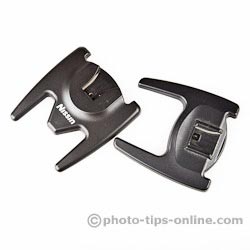 |
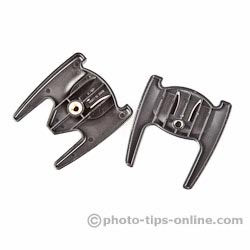 |
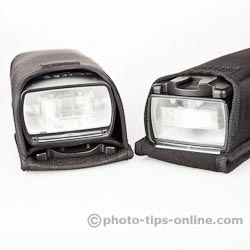 |
Despite the fact that Canon Speedlite 580EX II is being discontinued, it should be expected to be available new and used for years to come. It is likely that the same money will buy you either a new Nissin Di866 Mark II or used Canon Speedlite 580EX II. Which one to pick depends on the nuances of your personal use of the flash. Both units are the top-notch products, and you should not be disappointed with either one of them. Nissin Di866 II has the advantage of the "dumb" optical triggering, more intuitive menus, secondary flash, USB port, and several other things. The Canon's strong suit is the faster recycling with Ni-MH batteries, weather sealing, and exceptional quality.